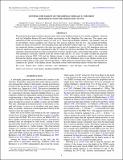HUNTING THE PARENT OF THE ORPHAN STREAM. II. THE FIRST HIGH-RESOLUTION SPECTROSCOPIC STUDY
Author(s)
Casey, Andrew R.; Keller, Stefan C.; Da Costa, Gary; Frebel, Anna L.; Maunder, Elizabeth
DownloadCasey-2014-HUNTING THE PARENT O.pdf (611.9Kb)
PUBLISHER_POLICY
Publisher Policy
Article is made available in accordance with the publisher's policy and may be subject to US copyright law. Please refer to the publisher's site for terms of use.
Terms of use
Metadata
Show full item recordAbstract
We present the first high-resolution spectroscopic study on the Orphan stream for five stream candidates, observed with the Magellan Inamori Kyocera Echelle spectrograph on the Magellan Clay telescope. The targets were selected from the low-resolution catalog of Casey et al.: three high-probability members, one medium, and one low-probability stream candidate were observed. Our analysis indicates that the low- and medium-probability targets are metal-rich field stars. The remaining three high-probability targets range over ~1 dex in metallicity, and are chemically distinct compared to the other two targets and all standard stars: low [α/Fe] abundance ratios are observed, and lower limits are ascertained for [Ba/Y], which sit well above the Milky Way trend. These chemical signatures demonstrate that the undiscovered parent system is unequivocally a dwarf spheroidal galaxy, consistent with dynamical constraints inferred from the stream width and arc. As such, we firmly exclude the proposed association between NGC 2419 and the Orphan stream. A wide range in metallicities adds to the similarities between the Orphan stream and Segue 1, although the low [α/Fe] abundance ratios in the Orphan stream are in tension with the high [α/Fe] values observed in Segue 1. Open questions remain before Segue 1 could possibly be claimed as the "parent" of the Orphan stream. The parent system could well remain undiscovered in the southern sky.
Date issued
2014-03Department
Massachusetts Institute of Technology. Department of PhysicsJournal
Astrophysical Journal
Publisher
Institute of Physics/American Astronomical Society
Citation
Casey, Andrew R., Stephan C. Keller, Gary Da Costa, Anna Frebel, and Elizabeth Maunder. "HUNTING THE PARENT OF THE ORPHAN STREAM. II. THE FIRST HIGH-RESOLUTION SPECTROSCOPIC STUDY." Astrophysical Journal, 784:19 (2014 March), pp.14. © 2014 American Astronomical Society.
Version: Final published version
ISSN
0004-637X
1538-4357